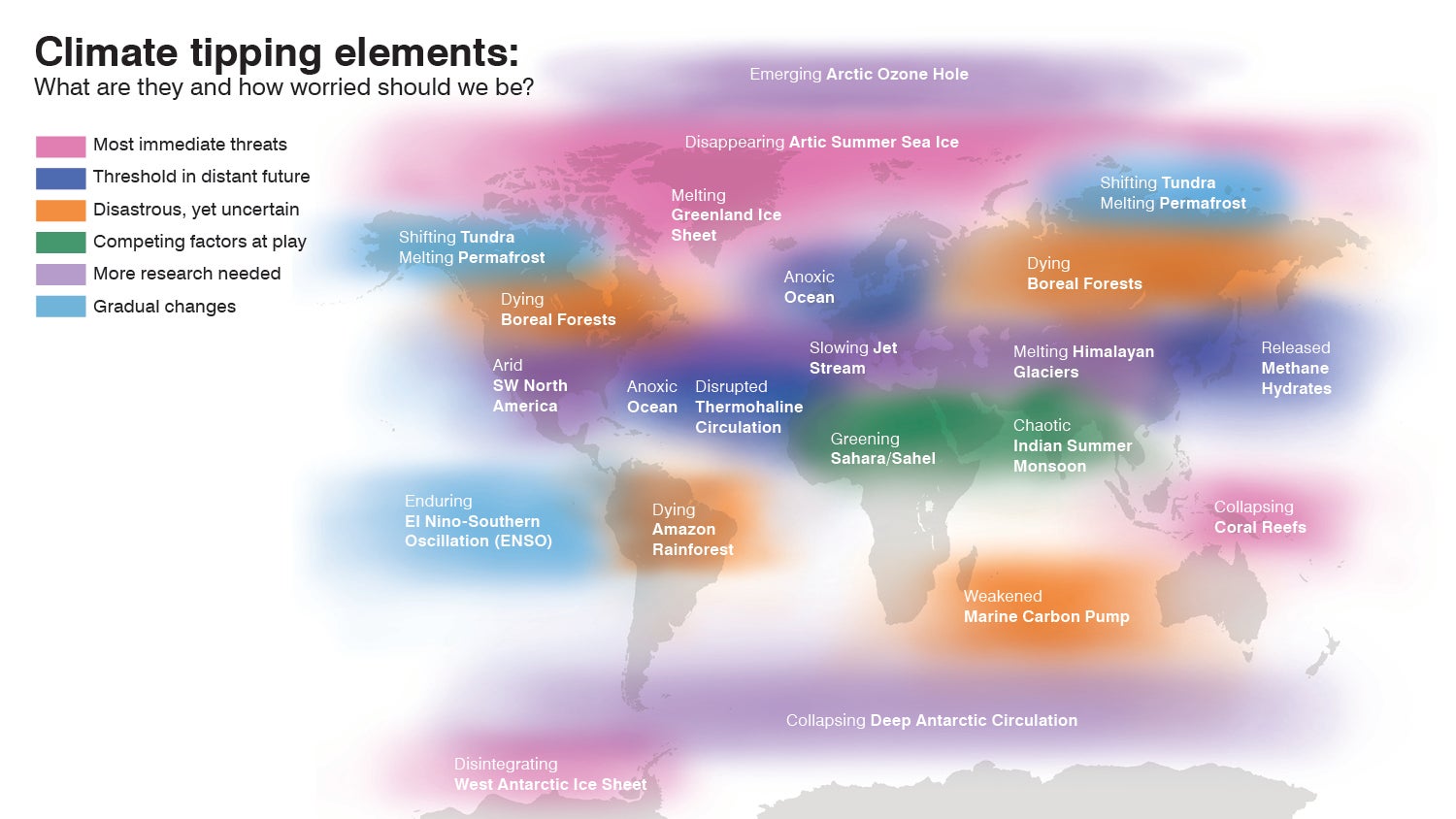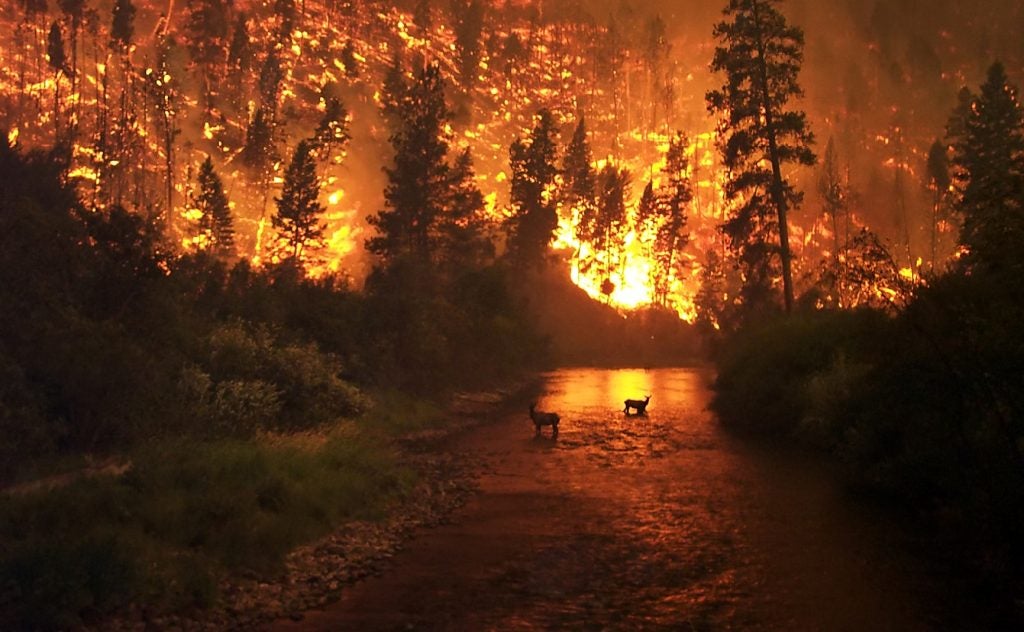(This post was co-authored by EDF Climate Scientist Ilissa Ocko)
Imagine cutting down a tree. Initially, you chop and chop … but not much seems to change. Then suddenly, one stroke of the hatchet frees the trunk from its base and the once distant leaves come crashing down.
It’s an apt metaphor for one of the most alarming aspects of climate change – the existence of “tipping elements.”
These elements are components of the climate that may pass a critical threshold, or “tipping point,” after which a tiny change can completely alter the state of the system. Moving past tipping points may incite catastrophes ranging from widespread drought to overwhelming sea level rise.
Which elements’ critical thresholds should we worry about passing thanks to human-induced climate change?
You can see the answer on this graphic – and find more information below.
The most immediate and most worrisome threats
- Disappearance of Arctic Summer Sea Ice – As the Arctic warms, sea ice melts and exposes dark ocean waters that reflect sunlight much less efficiently. This decreased reflectivity causes a reinforcement of Arctic warming, meaning that the transition to a sea-ice free state can occur on the rapid scale of a few decades. Some scientists have suggested that we have already passed this tipping point, predicting that Arctic summers will be ice-free before mid-century.
- Melting of the Greenland Ice Sheet – The Arctic warming feedback described above may one day render Greenland ice-free. Research predicts that the tipping point for complete melt can occur at a global temperature rise of less than two degrees Celsius – a threshold that may be surpassed by the end of this century. While the full transition to an ice-free Greenland will take at least a few hundred years, its impacts include global sea level rise of up to 20 feet.
- Disintegration of the West Antarctic Ice Sheet – The bottom of this ice sheet lies beneath sea level, allowing warming ocean waters to slowly eat away at the ice. There is evidence that this tipping point has already been surpassed – possibly as early as 2014. Like the Greenland Ice Sheet, full collapse would require multiple centuries, but it could result in sea level rise of up to 16 feet.
- Collapse of Coral Reefs – Healthy corals maintain a symbiotic relationship with the algae that provide their primary food source. As oceans warm and become more acidic, these algae are expelled from the corals in an often fatal process called coral bleaching. Research predicts that most of our remaining coral systems will collapse even before a global temperature rise of two degrees Celsius.
Tipping points in the distant future
- Disruption of Ocean Circulation Patterns – The Thermohaline Circulation is driven by heavy saltwater sinking in the North Atlantic, but this water is becoming fresher and lighter as glaciers melt in a warming climate. The change in water density may prevent sinking and result in a permanent shutdown of the circulation. Research suggests that weakening of the Thermohaline Circulation is already in progress, but that an abrupt shutdown is unlikely to occur in this century. Some models suggest that these changes may prompt a secondary tipping element in which the subpolar gyre currently located in the Labrador Sea shuts off. Such a change would dramatically increase sea level, especially on the eastern coast of the United States.
- Release of Marine Methane Hydrates – Large reservoirs of methane located on the ocean floor are stable thanks to their current high pressure-low temperature environment. Warming ocean temperatures threaten the stability of these greenhouse gas reservoirs, but the necessary heat transfer would require at least a thousand years to reach sufficient depth, and may be further delayed by developing sea level rise.
- Ocean Anoxia – If enough phosphorous is released into the oceans – from sources including fertilizers and warming-induced weathering, or the breakdown of rocks –regions of the ocean could become depleted in oxygen. However, this process could require thousands of years to develop.
Potentially disastrous elements, but with considerable uncertainty
- Dieback of the Amazon Rainforest – Deforestation, lengthening of the dry season, and increased summer temperatures each place stress on rainfall in the Amazon. Should predictions that at least half of the Amazon Rainforest convert to savannah and grasslands materialize, a considerable loss in biodiversity could result. However, the dieback of the Amazon Rainforest ultimately depends on regional land-use management, and on how El Niño will influence future precipitation patterns.
- Dieback of Boreal Forests – Increased water and heat stress could also lead to a decrease in boreal forest cover by up to half of its current size. Dieback of boreal forests would involve a gradual conversion to open woodlands or grasslands, but complex interactions between tree physiology, permafrost melt, and forest fires renders the likelihood of dieback uncertain.
- Weakening of the Marine Carbon Pump – One mechanism through which oceanic carbon sequestration takes place is the marine carbon pump, which describes organisms’ consumption of carbon dioxide through biological processes such as photosynthesis or shell building. As ocean temperatures rise, acidification progresses, and oxygen continues to be depleted, these natural systems could be threatened and render the carbon sequestration process less efficient. More research is necessary in order to quantify the timescale and magnitude of these effects.
Tipping elements complicated by competing factors
- Greening of the Sahara/Sahel – As sea surface temperatures rise in the Northern Hemisphere, rainfall is projected to increase over the Sahara and Sahel. This increased rainfall would serve to expand grassland cover in the region, but is balanced by the cooling effect of human-emitted aerosols in the atmosphere.
- Chaotic Indian Summer Monsoon – The fate of the Indian Summer Monsoon similarly depends upon a balance of greenhouse gas warming and aerosol cooling, which strengthen and weaken the monsoon, respectively. On the timescale of a year, there is potential for the monsoon to adopt dramatic active and weak phases, the latter resulting in extensive drought.
More research necessary to establish as tipping elements
- Collapse of Deep Antarctic Ocean Circulation – As in the case of the Thermohaline Circulation, freshening of surface waters in the Southern Ocean due to ice melt may slowly alter deep water convection patterns. However, the gradual warming of the deep ocean encourages this convection to continue.
- Appearance of Arctic Ozone Hole – Unique clouds that form only in extremely cold conditions currently hover over Antarctica, serving as a surface for certain chemical reactions and facilitating the existence of the ozone hole. As climate change continues to cool the stratosphere, these “ice clouds” could begin formation in the Arctic and allow the development of an Arctic ozone hole within a year.
- Aridification of Southwest North America – As global temperatures rise, consequential changes in humidity prompt the expansion of subtropical dry zones and reductions in regional runoff. Models predict that Southwest North America will be particularly affected, as moisture shifts away from the southwest and into the upper Great Plains.
- Slowdown of the Jet Stream – A narrow and fast moving air current called a jet stream flows across the mid-latitudes of the northern hemisphere. This current separates cold Arctic air from the warmer air of the south and consequentially influences weather in its formation of high and low pressure systems. A slowing of the jet stream has been observed over recent years. Should slowing intensify, weather patterns could persist over several weeks with the potential to develop into extended extreme weather conditions.
- Melting of the Himalayan Glaciers – Several warming feedbacks render the Himalayan glaciers vulnerable to dramatic melt within this century, though limitations on data availability complicate further study. Dust accumulation on the mountainous glaciers and the continual melt of snow and ice within the region both prompt a decrease in sunlight reflectivity and amplify regional warming.
Gradual, continuous changes
- More Permanent El Nino State – 90 percent of the extra heat trapped on Earth’s surface by greenhouse gases is absorbed by the oceans. Though still under debate, the most likely consequence of this oceanic heat uptake is a gradual transition to more intense and permanent El Nino/Southern Oscillation (ENSO) conditions, with implications including extensive drought throughout Southeast Asia and beyond.
- Permafrost Melting – As global temperatures rise and the high latitudes experience amplified warming, melting permafrost gradually releases carbon dioxide and methane into the atmosphere and creates a feedback for even more warming.
- Tundra Transition to Boreal Forest – Much like the conversion of the Amazon Rainforest and boreal forests to other biomes, tundra environments may transition into forests as temperatures increase. However, this process is more long-term and continuous.
With a range of critical thresholds on the horizon, each tipping element demonstrates the potential implications of allowing climate change to progress unchecked.
As tipping points loom ever closer, the urgency for emissions mitigation escalates in hopes of sustaining the Earth as we know it.













